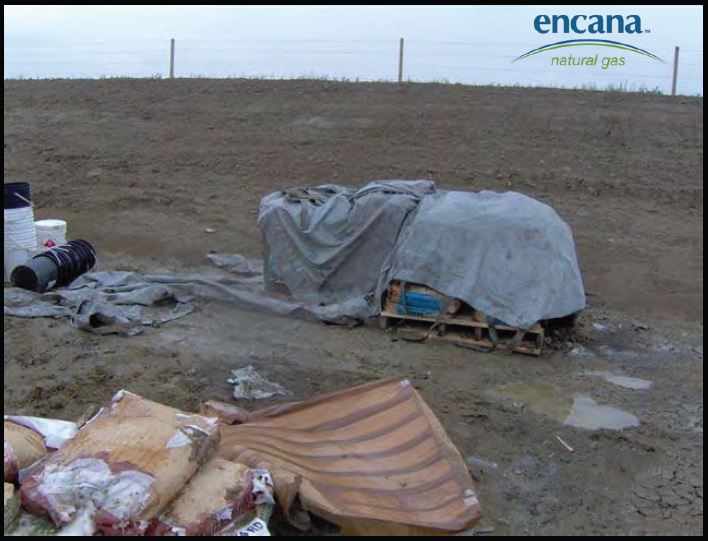Where’s Alberta’s Attorney General?
2015 12 19: CHEMICALS ILLEGALLY INJECTED BY ENCANA IN 2004 INTO ROSEBUD’S DRINKING WATER AQUIFERS REMAIN SECRET, CONTRARY EVEN TO ALBERTA’S RULES OF COURT:
Encana still has not filed with Ernst cleaned up records for their document exchange (which had a December 19, 2014 deadline ordered by Chief Justice Wittmann); chemicals Encana injected into Rosebud’s drinking water aquifers also not yet disclosed, even though required under the Court Rules, including all trade secrets.
Fracfocus.ca was only mandated in Alberta to start in January 2013 by AER and only for some frac chemicals, no chemicals for the other many parts of the process require disclosure, eg drilling additives which can be more toxic than frac chemicals.
All chemicals (except nitrogen) injected during drilling, cementing, lost circulation, blow outs and frac hit repair, perforating, fracturing, stop water production treatments, acidizing, servicing etc, before January 2013 remain secret in Alberta, including relevant and important in the Daunheimer and Ernst lawsuits. Is that why the Alberta Government appointed Protti to chair the legally immune, law violating regulator?
How many hundreds of thousands of dollars will Daunheimers and Ernst be forced to sacrifice via Alberta courts to try to compel Angle/Bellatrix and Encana to heed the Rules of Court and disclose all chemicals injected? Under the Rules of Court, even if Albertans win in Court to force disclosure by the oil companies, only about 4% of legal costs to try to force that disclosure to happen can be claimed – worse, the citizens have to pay more legal fees to try to make the companies pay those puny portions back. Were rules of court in Alberta changed to bankrupt frac harm lawsuits before they get through discovery?
 Slide from Ernst presentations
Slide from Ernst presentations
Hydraulic fracturing chemicals reporting: Analysis of available data and recommendations for policymakers by Katherine Konschnika and Archana Dayalub, Energy Policy
Volume 88, January 2016, Pages 504–514, Received 4 August 2015, Revised 3 November 2015, Accepted 4 November 2015, Available online 3 December 2015
doi:10.1016/j.enpol.2015.11.002
Highlights
• 96,449 FracFocus forms were analyzed, including 1,979,128 ingredient records.
• Rates of withheld chemical ingredients are increasing in FracFocus.
• State rules shortened submission time but did not affect data quality or withholding.
• Systems approach reporting reduces withholding by more than four-fold.
Abstract
Twenty-eight states require disclosure of hydraulic fracturing chemicals. Twenty-three states direct reporting to FracFocus; additionally, companies in other states use this registry. FracFocus contains the most comprehensive dataset on fracturing chemicals but faces data quality and transparency criticisms. In response, FracFocus announced upgrades, and since May 2015, publishes aggregated data. We used Linux and R version 3.2.0 to clean and analyze 96,449 forms submitted between March 9, 2011 and April 13, 2015 for accuracy, completeness, and timeliness. We characterize data, and compare results to state law and industry practice, to suggest how to induce more accurate and complete disclosures. We find that rates of withheld chemical information have increased since 2013, and appear unaffected by different legal requirements. However, when companies report fracturing chemicals without attribution to the specific products in the fracturing fluid (a “systems approach” to reporting), withholding rates drop four-fold. State deadlines shortened reporting timelines, but compliance rates are low absent indication states will enforce. Automatic field population and prompts in FracFocus can reduce data error, while enforcement signals, education, and harmonized requirements may boost compliance and enhance disclosure. Systems reporting should occur, with states retaining authority to request product-specific ingredient lists. [Emphasis added]
[Refer also to:

2006: Encana chemicals in the rain on lease on farmland near Rosebud. During the early frac experiment years, no chemical disclosure was required certainly not to harmed communities or family farms, even though the AER lied in public and said it was.
Slide from Ernst presentations
2013 02 03: Evidence Presented by Encana to 41st PARLIAMENT, 1st SESSION Standing Committee Natural Resources; Encana taking step to stop frac’ing with benzene, diesel, chromium, arsenic, mercury etc [Encana lying in official testimony? May 2013 Encana data shows the company continues to frac with diesel in Alberta]
2012 12 20: Alberta to start using FracFocus [Did the AER mandate Fracfocus because industry knows it fails?]
2012 09 12: Two-thirds of frack disclosures omit ‘secrets’ [Disclosure or Toxic cover-up?]
2012 08 17: Diesel still used to frack wells FracFocus data show

2006: Pallets of petroleum distillates on Encana frac site near Rosebud. Slide from Ernst presentations.
Testing by Alberta Environment found evidence of petroleum distillates in Rosebud Hamlet’s, Signer’s and Ernst’s well water after Encana illegally frac’d the community’s fresh water aquifers. ]
